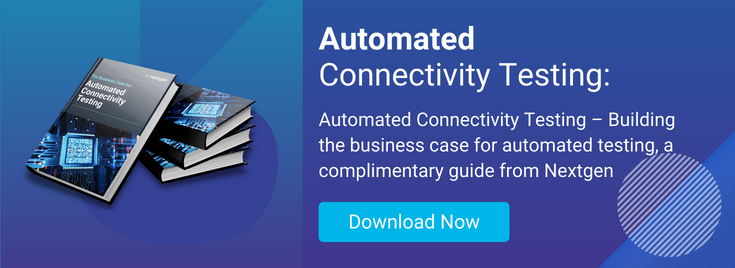The Top 5 Connectivity Challenges Facing The IoT In 2023

Good connectivity is fundamental to the Internet of Things (IoT), enabling commercial devices to communicate seamlessly with routers, servers, control applications, and other IoT devices such as an Industry 4.0 manufacturing production line.
With millions of IoT-enabled devices now used in businesses and homes – and many more applications in development – the IoT cannot exist without high-quality, reliable connectivity, and a flow of dependable (and secure) data. Efficient and reliable communication is crucial for devices to operate correctly, with the IoT now permeating a wider variety of sectors, from smart homes and healthcare to manufacturing and transportation.
Addressing the following connectivity challenges is, therefore, imperative for the Internet of Things to provide dependable connectivity and performance.
1. Bandwidth
Sufficient bandwidth is a major consideration in IoT connectivity for businesses implementing automated production and management solutions. IoT networks generate an unparalleled quantity of data, and this can put strain on existing network infrastructure when thousands of devices are sending request and response signals over the same network.
The more complex the network, the greater the need for available bandwidth to sustain smooth operations. Wireless IoT networks may also be impeded by physical limitations in the workplace such as obstacles such as machinery and walls reducing range and signal strength. This can lead to slow speeds, interrupted data flows, and even dropped connections and production downtime in some cases.
There is a widespread need for improved deployment of infrastructure and hardware across the UK if businesses are to take full advantage of IoT-enabled business processes. For optimum reliability, large-scale server clusters must be able to manage seamless data exchange and deliver a fast and always-on responsive service
This change isn’t an overnight process: network operators need to improve their capacity by investing in additional bandwidth, along with increasing the connectivity available to businesses.
In the meantime, an interim cost-effective solution for business is to implement software solutions that optimise bandwidth utilisation and reduce latency on site, such as traffic prioritisation, dynamic spectrum sharing, Edge Computing, and cloud optimisation. Advances in 5G technology also enable faster speeds and better connections for IoT devices, allowing a wider range of applications and services.
2. Power Management
Efficient power management is critical when developing a high-level IoT architecture.
When devices need varying levels of power, it becomes more challenging to manage energy effectively and efficiently, leading to connectivity issues. Put bluntly, IoT devices and sensors require uninterrupted power, and if the power source is unreliable, it will lead to a disruption in service.
Therefore, minimising power requirements for IoT devices as well as achieving low power consumption, and increasing power continuity is essential.
To address these drawbacks, developers can utilise low-power wide area networks (LPWANs). These networks allow the deployment of long-range, low-power radio signals that are reliable and cost effective with the added benefit of having low power consumption needs. Power over Ethernet, in which electric power and data are simultaneously transmitted across a data pair on ethernet cables, provides a more efficient way to power IoT devices that require a connection to the network.
Novel solutions such as energy harvesting from sustainable IoT companies like EnOcean– in which energy is drawn from the operating environment, such as operating a switch, and is converted for use in powering wireless IoT devices. Improved device design and optimisation, and optimised deployment of wireless networks, can all help improve power management for individual businesses and applications. Improvements in battery technology are also enabling better storage of energy and longer life spans for fixed and non serviceable IoT devices.
There isn’t, unfortunately, a one size fits all solution to power management for the IOT that meets the needs of all businesses. To avoid unexpected issues, custom power management strategies should be implemented in the early development stages for IoT deployment, with a tailored solution that meets the expected power usage requirements of the network, while leaving surplus capacity available for upgrades and future expansion.
3. Data Signalling And Communication
Data streams and IoT messages are vulnerable to loss or corruption arising from many factors, so reliable bidirectional signalling is essential for the efficient collection and routing of data – particularly for time-critical data streams or if a wide connectivity range is desired.
Older standard mobile signalling methods such as SMS and USSD are not adequate for many IoT applications due to their GSM architecture and limited capacity and speed. Numerous alternative communication IP based protocols have been successfully adopted by IoT applications, including MQTT, CoAP, and XMPP. These protocols enable devices to communicate with each other over high-speed internet connections with greater reliability and scalability than traditional methods.
Furthermore, developments in mesh networks – a group of connected networked devices that operate as a single network – now facilitate better signalling and more seamless communication between multiple devices. Mesh networks deliver greater reliability for IoT applications due to their ‘self-healing capabilities’, in which communications are immediately rerouted through another node if one connectivity device goes off-line, and are ideal for use in remote locations where connectivity may be limited.
4. ‘Smart Cities’
Seoul, South Korea is home to Songdo, designed to be the world’s first Smart City, where electronic data collection and connectivity between public services aim to deliver higher economic growth, better quality of life, and improved sustainability. Despite over a decade of work in planning and development, Songdo remains a work in progress, and it will be interesting to see how this and other Smart City projects develop over the coming years as different models for how we will live in cities in the future are explored.
Smart infrastructure projects are also being implemented around the world – e.g. the data management and monitoring systems used to administer the expanded Ultra Low Emission Zones in London and Birmingham in the UK. However, for the vision of a truly inter-connected Smart City to become a reality, reliable data connectivity between IoT devices, processes, and systems is essential.
So far at least, there is no ‘governing AI’ capable of efficiently and autonomously administering multiple data streams from an information network as large and varied as a Smart City. With access to a vast amount of accurate real time data (e.g. on traffic congestion, air quality etc), the challenge is for an intelligent system to make fast, responsive and effective decisions that enhance the experience of living and working in smart urban areas. For designers and developers of AI smart urban systems, this poses important challenges, as the complexity of systems, different wireless standards, and a vast volume of devices and data are required to work safely, consistently and predictably to offer a better quality of life to the inhabitants of the smart city.
5. IoT Device Monitoring
Device monitoring ensures that each IoT device is correctly identified when it joins or disconnects from a network – and is integral to the effective and secure functioning of an IoT infrastructure. To overcome connectivity and performance issues when devices go offline, continuous monitoring of each device’s state is required. This supports the identification of network issues in real time and makes issues faster to identify and easier to resolve.
However, there are several challenges to be addressed in order to ensure accurate and reliable results from device monitoring.
- Diverse ecosystems and the lack of a unified platform for device monitoring may make it difficult to track performance and collect reliable data across multiple devices and locations.
- Many current monitoring solutions rely on manual input and are not able to automatically detect and diagnose issues.
- The sheer quantity of data generated by IoT devices can make monitoring and security problematic. This data can be difficult to interpret and act upon in a timely manner without the use of AI based control systems.
Advanced monitoring solutions include consolidated cloud-based analytics platforms, allowing real-time data monitoring of multiple devices and the rapid detection and diagnosis of network issues; while AI machine learning algorithms can automate the process of detecting and diagnosing anomalies in data, streamlining the process, and enabling both greater monitoring capacity and accuracy.
6. Data Security For IoT Devices And Networks
Robust data security is essential for IoT networks. Unfortunately, IoT networks are particularly susceptible to cyber threats due to their network topology, large data volumes and their distributed nature.
Security researchers have not been slow to realise this. Hackers may gain access to IoT networks through vulnerabilities in wireless connections or by exploiting exposed vectors and vulnerabilities in connected devices. Once inside a trusted network, attackers can launch malicious attacks such as man-in-the-middle (MITM), hidden gateway and remote access vector attacks. To reduce these threats when implementing IoT systems, businesses should ensure that strong authentication protocols (such as OAuth2 or JWT) are in place, as well as secure, high entropy encryption technologies (e.g. AES 256) to safeguard sensitive data. Network firewalls and secure gateways should be implemented to safeguard points of ingress and egress and restrict access to block potential attacks – and active monitoring and network segmentation can also reduce the attack vector and overall cyber security risk.
Reinforce Your QA Process With High-Quality Connectivity Testing
In conclusion, the challenges facing the IoT in 2023 are complex, but not insurmountable. With the right investment in infrastructure and hardware, smart power management, effective data signalling, smart city development, advanced device monitoring, and robust data security, businesses can overcome the connectivity hurdles that can otherwise disrupt operations and impede growth. And one of the keys to ensuring a high-quality connected product is to reinforce your QA process with high-quality connectivity testing. Automated testing can help ensure that devices are functioning properly and communicating with each other effectively throughout the development process and during the product lifecycle, helping to minimise the risk of connectivity issues and maintain the performance and reliability of IoT devices. By investing in these solutions and making them an integral part of their IoT strategy, businesses can fully realise the potential of this transformative technology, delivering greater value to their customers, and driving innovation and growth in the years to come.
Nextgen offer reliable and cost-effective codeless automated connectivity testing to support IoT product development strategy and quality assurance processes, helping businesses create better connected products for the IoT.
To find out more, please book a demo at a time to suit or call Nextgen on +44 3331 120 000.




